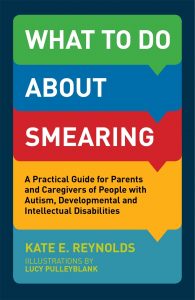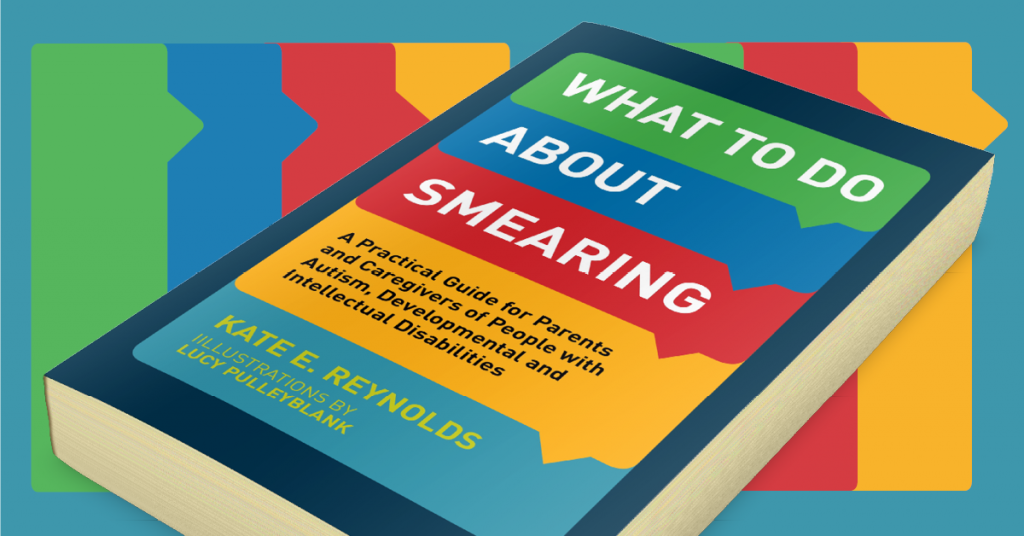In this blog Kate Reynolds, the author of What to do About Smearing, addresses the issue of smearing and what parents and carers of children with autism can do when they are confronted with this type of behaviour.
This isn’t as unusual as you might think. The problem is that people don’t tend to discuss smearing, which can be anything from wiping a hand covered in poop on the wall to literally plastering excrement over furniture, bedding, the child themselves or other children/animals nearby. Sometimes the child may even eat poop. It’s a smelly, dirty and deeply embarrassing behaviour for many parents and caregivers, so you don’t feel able to admit your child does it. Instead you become more and more isolated and find it difficult to visit friends or family or even leave the home in case your child smears.

So what can you do if you find yourself confronted with smearing?
- Keep your response as low key as possible. This is incredibly easy to say when you’re faced with poop everywhere, overwhelming odours and usually an active poop-covered child/young person to manage. It may make you feel better to vent feelings of anger or despair, but this will be a temporary result. Try to remember that if you give a dramatic response this may encourage further episodes.
- Yes, there’s the clear up. Again, keep your reactions level and low key. Some advice online suggests that you should get the child/young person to either partially or wholly do the clear up, usually with the parent admitting that the practise hasn’t stopped the smearing but just made the parent feel better. I disagree with this practise, partly because there is no evidence that it works and it is based on a misguided assumption that the child is behaving vengefully. What to do about Smearing examines the many and varied reasons for smearing behaviour which make it clear that this sort of punitive practice isn’t constructive.
- Try and work out what happened before the smearing and document it because it’s easy to forget exactly what happened the day after or the day after that, especially if there have been more episodes. Think: Was the child/young person in bed and had been straining to poop on the toilet earlier that day? How occupied was the child/young person before the smearing happened? Was anyone else there, such as a sibling? Where is the child/young person when it happened– on the toilet? In bed?
- Really look at what the smearing involved. Think: Is there a lot of poop or a smudge? Has the child/young person got a lot of poop on their hands or are squeezing it between their fingers? Is the poop smeared over the genital area or their face or mouth? Is the poop hard or soft? Document this information as well because otherwise episodes all blend into one awful, despairing experience.
- What do you usually do when smearing happens? I’ve mentioned the response level is important, but also think: Does the child/young person achieve anything, such as being moved somewhere else, or getting company? Again, write this down. It is much easier for a professional (or you) to work out the cause of the smearing if there’s a diary to examine.
What to do about Smearing has one or two surprises for readers, I’m told. Perhaps the most surprising thing is that smearing has many possible causes and therefore many ways to help improve the situation or eradicate the behaviour. Controversially, I don’t endorse restrictive clothing, such as pinning children into back-to-front ‘onesies’, which can undermine positive approaches to smearing and may worsen smearing behaviour. Additionally, smearing isn’t something that only people with intellectual disabilities or more severe form of autism do; there are some cases in which the person has so-called higher functioning autism.
The causes range from sensory input gained from smearing, to lack of toilet skills, medical issues underlying smearing (notably constipation) sexual abuse, other sexual reasons, lack of occupation and psychiatric conditions. In most instances the child should be referred for a professional opinion to work out the causes.
In What to do about Smearing I outline a range of practical things we can do as parents and caregivers to tackle smearing. Tackling smearing needs positive behavioural approaches and efforts to pinpoint individual issues. It can be utterly exhausting having a child with additional needs and more so when the behaviours you’re dealing with feel as repulsive as smearing can. However I hope this book gives you ideas and knowledge to put into practise and an understanding that you’re not alone. Smearing isn’t “just part of disability” as many people think; it can be minimised, eradicated and further episodes prevented.
If you would like to read more articles like Kate’s and get the latest news and offers on our autism books, why not join our mailing list? We can send information by email or post as you prefer. You may also be interested in liking our Autism, Asperger’s and related conditions Facebook page.

My son blayde is still in nappies at 16 non-verbal , clinically blind in 1 eye retinal detachment in other, Autism, intellect delay, adha and pica I’ve tried all advice given to me via books and other parent’s, still he smears nearly every night. Could it be attention for him to have a shower? Curious only because he loves the water. If my son could swim or shower all the time he would.